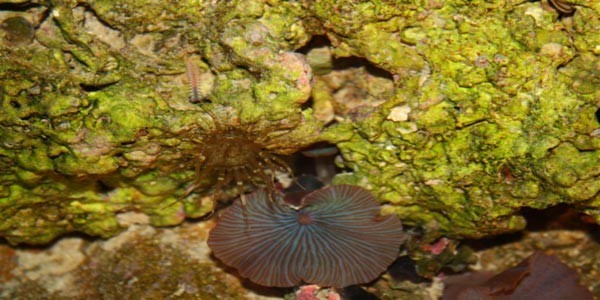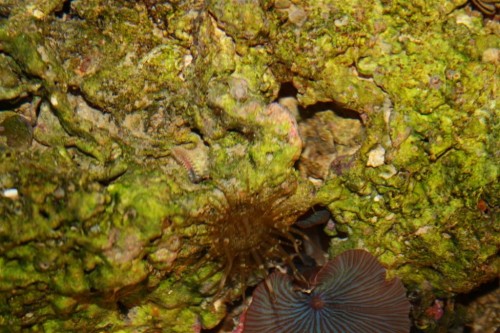
I discovered this weekend that I had the beginnings of an Aiptasia infestation in my 29 gallon biocube. After spending a little time on Google I selected a very quick and effective method for eradicating this pest from my aquarium. This method is informally known as “Death by Fire!”
Aiptasia is a species of anemone that is known for stinging other more desirable corals. This species will grow to plague proportions in an aquarium if it is not dealt with swiftly. It is highly regenerative and just pulling it out of the live rock will still leave enough tissue behind for it to regenerate. Worse yet, if you do decide to pull it out you’ll usually leave tissue floating in the water column allowing it to spread even more rapidly.
I first noticed the aiptasia about 2 months after I first setup the tank. It was a hitchhiker on one of the live rocks and at the time I did not know what it was. With the original arrangement of my aquarium it wasn’t near any other coral so I left it alone, however after rearranging the aquarium I placed a collection or mushroom corals a little too close. After just a few days the mushroom coral started showing signs that it was under attack.

The section of the mushroom coral that was closest to the aiptasia started to curl back and it turned white almost as if it had been burned. I started researching what this mystery coral might be and that’s when I came across this web page: http://www.wetwebmedia.com/marine/inverts/cnidaria/anthozoa/aiptasia/aiptasia.htm
I wasn’t keen on using chemicals to remove this coral because I didn’t want the treatment to hurt any of the other corals in the tank. The tank is less than 6 months old, so I didn’t want to add any predators to the tank because of the extra biomass. I started searching for an alternative method and I found one that was not only effective it also gave the Aiptasia a double taste of it’s own medicine. The process of eradication through “HOT FIERY DEATH” comes from our friends over at ReefBuilders.com and as they have suggested, I have made a video of the process:
Another added benefit from this process is that my cleaner shrimp went to town on the ashes that remained. There is a short-term downside of your live rock have black scars on it for a while but it will soon fade away as the coralline algae covers it back up.
I have uploaded the rest of the pictures to Facebook here: www.facebook.com/eXtremeAquatics








How did the bon fire turn out? I also found some aiptasia growing in my micro reef 2 weeks ago.I used a peppermint shrimp and I havent seen any more. He doesnt seem to bother any of my corals either. And from what ive read, they only like aiptasia under an inch tall. What do the burned patches look like now? And did it effect any water, coraline or coral themself? My reef is only a 2.5g aga tank so I didnt think I could risk the corals to a chem change in that little of water.
Burning the aiptasia off worked great, but it didn’t take long for them to come back. I now have 4 aiptasia corals that I can see, so I’ll be making a trip back to the pet store soon to pickup some peppermint shrimp. They should get the job done.
After my peppermint shrimp ate all the aiptasia, he started going after my rhodactus and zoos. I took him out and put him in my fowlr tank and my puffer ate him. Now I see the same spot growing back.
I changed my tank from 2.5g to a 10g tank so that I dont have to change water every other day, now its once a week.
That’s a bummer. I am concerned that the peppermint shrimp might get after some of my other corals. I’ll have to keep a close eye on it. I’m planning on picking him up tomorrow from the Southwest Reef Company.